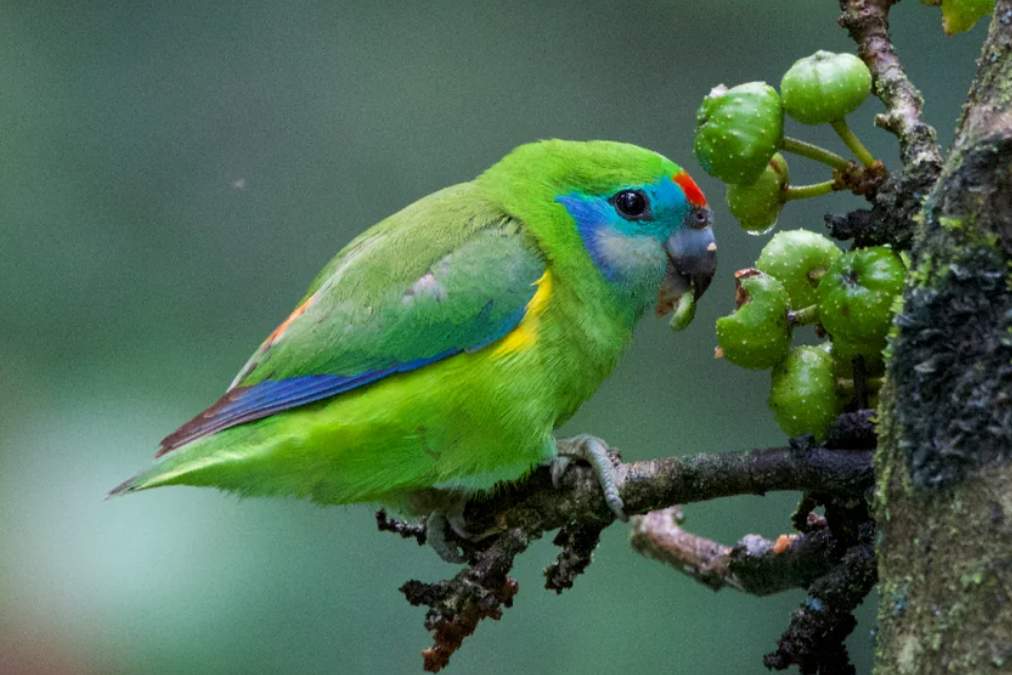The Wompoo Fruit Dove (Ptilinopus magnificus) is the most prominent fruit dove and is radiantly hued. However, in the lowland rainforests where it lives, the bird is inconspicuous. It is also known as Wompoo Pigeon, Wompoo Fruit Pigeon, Green Pigeon, Magnificent Fruit-Dove, Purple-breasted Pigeon, and Bubbly Mary.
Wompoo Fruit-Dove lives entirely in densely foliaged trees and never touches the ground. When flying, it weaves its way through the tall rainforest canopy, but just above the canopy in lower types of rainforest. Its flight is quite heavy. These fruit doves live in pairs or small parties, although they sometimes gather in large groups in a favorite feeding tree. Wompoo Fruit-Dove’s identity call is a loud, baritone-like, far-carrying wallock-a-woo. Other calls include bah-roo, a single, explosive boo, and a low pak-pak when feeding.
They are sedentary but move around locally to follow different trees’ fruiting in the rainforest. Like others of the genus Ptilinopus, they are very agile feeders. They crawl over the foliage, often along very thin twigs, and hang upside down like parrots to reach berries. In dense forests, its presence is revealed as often by the sound of fruit falling through the undergrowth as by its strange, human-like voice.

The birds’ food varies from place to place, according to the types of trees in the rainforest. It also differs from year to year because of the irregular fruiting cycles of many trees. In northeastern New South Wales, wild figs, particularly the smaller varieties, are their most significant food in the summer. In winter, Wompoo Fruit Doves rely on white cedar fruit. They also feed on rose maple, lilly-pilly, native ivy, and wild lime. In northeastern Queensland, their diet is more diverse; they eat the fruit of more than 50 trees and vines—mainly blue quandong, rusty laurel, woolly pine, boll woods, and palms. Nearly all foraging is done near the forest canopy.
Although Wompoo fruit doves are protected, many are still shot in some places. Their loud call and habit of staying in one tree until fruit is released make them easy targets. The southern race was once abundant but is now rare, the main cause being extensive rainforest clearing for agriculture and heavy shooting in the remaining pockets. The northern races have not been so badly affected, for much virgin land remains; a continuing clearing could have serious results.
Wompoo fruit doves are 360–450 mm long, including a long tail. Adults: Both sexes are similar. The head is light gray; the upper parts and tail are yellowish green. Moreover, the feathers have a blue tinge. Neck and throat are light gray; breast and lower breast are bright purple; vent and undertail coverts are dull yellow. In addition, the underside of the tail is gray, the underside of the wing shoulder is yellow, and the underside of the flight feathers is grey. Eyes are red-orange. Bill is orange-red with a yellow tip. Feet are yellow-green; claws are darker. There is a purple breast blotched irregularly with green, and the eyes are brown in the immature
The dove lays one smooth, lustrous white egg, ellipsoidal or long-oval, 35–48 x 24–30 mm, the largest in the southern races. Most nesting and breeding take place between June and January, but mostly between August and October. At the end of long, slender branches at 5–20 meters high, nest a platform of slender sticks about 150 mm in diameter, built in a horizontal fork to create a nest of slender sticks.
Wompoo Fruit Doves are found in the lowland and neighboring highland rainforests, originally from the Illawarra of New South Wales to the Cape York Peninsula. Today, it is seldom seen south of Bellinger River, NSW, and is uncommon in New South Wales generally. There are three races: one huge on the central east coast north to near Bowen; another large in northeastern Queensland from Sea View Range to Cooktown; and a third medium-sized with reddish-toned breasts on the Cape York Peninsula. Other small red-breasted races occur in lowland New Guinea.
Read More: Rose-crowned Fruit-dove (Ptilinopus regina)







